Dent's horseshoe bat facts for kids
Quick facts for kids Dent's horseshoe bat |
|
|---|---|
| Conservation status | |
| Scientific classification | |
 |
|
| Dent's horseshoe bat range |
The Dent's horseshoe bat (Rhinolophus denti) is a type of bat. It belongs to a group of bats called Rhinolophidae. You can find these bats in several African countries. These include Angola, Botswana, Ghana, Guinea, Guinea-Bissau, Namibia, South Africa, and Zimbabwe. They like to live in dry savannah areas. They often rest and sleep in caves or other underground places.
What Does Dent's Horseshoe Bat Look Like?
The Dent's horseshoe bat is quite small. It is about 7 cm (2.8 in) long. That's about the length of a pen. It weighs around 6 g (0.2 oz). This is lighter than a pencil. Its fur is long and feels soft like silk. The fur on its back is light brown or grey. Its belly is a lighter color. The bat's wings are brown. They have white edges.
How Do These Bats Live?
Dent's horseshoe bats live in groups. These groups can be small, with just a few bats. Or they can be large, with over a hundred bats. They usually rest in cool, damp caves. These bats can enter a special state called torpor. This is like a deep sleep. It helps them save energy when it's cold or food is scarce.
These bats are insectivores. This means they eat insects. They catch many different kinds of soft-bodied insects. They hunt for food at night while flying. Not much is known about how they have babies. But it is thought to be similar to other Rhinolophus bats. Usually, a mother bat has one baby. The baby can take care of itself about two months after it is born.
Where Do Dent's Horseshoe Bats Live?
Dent's horseshoe bats live in two main areas. These areas are hundreds of kilometers apart. One group lives in West Africa. You can find them in Senegal, Guinea, Guinea-Bissau, and Ghana. The other group lives in southern Africa. They are found in southern Angola, Namibia, western Botswana, western Zimbabwe, and northern South Africa.
Scientists think there might be more of these bats than we know. But so far, fewer than 100 groups are known in West Africa. And fewer than 200 groups are known in Southern Africa. We don't know if their numbers are growing or shrinking. They don't face many big threats. The main concern is if their resting places are disturbed. The International Union for Conservation of Nature says these bats are of "least concern". This means they are not currently in danger of disappearing.


